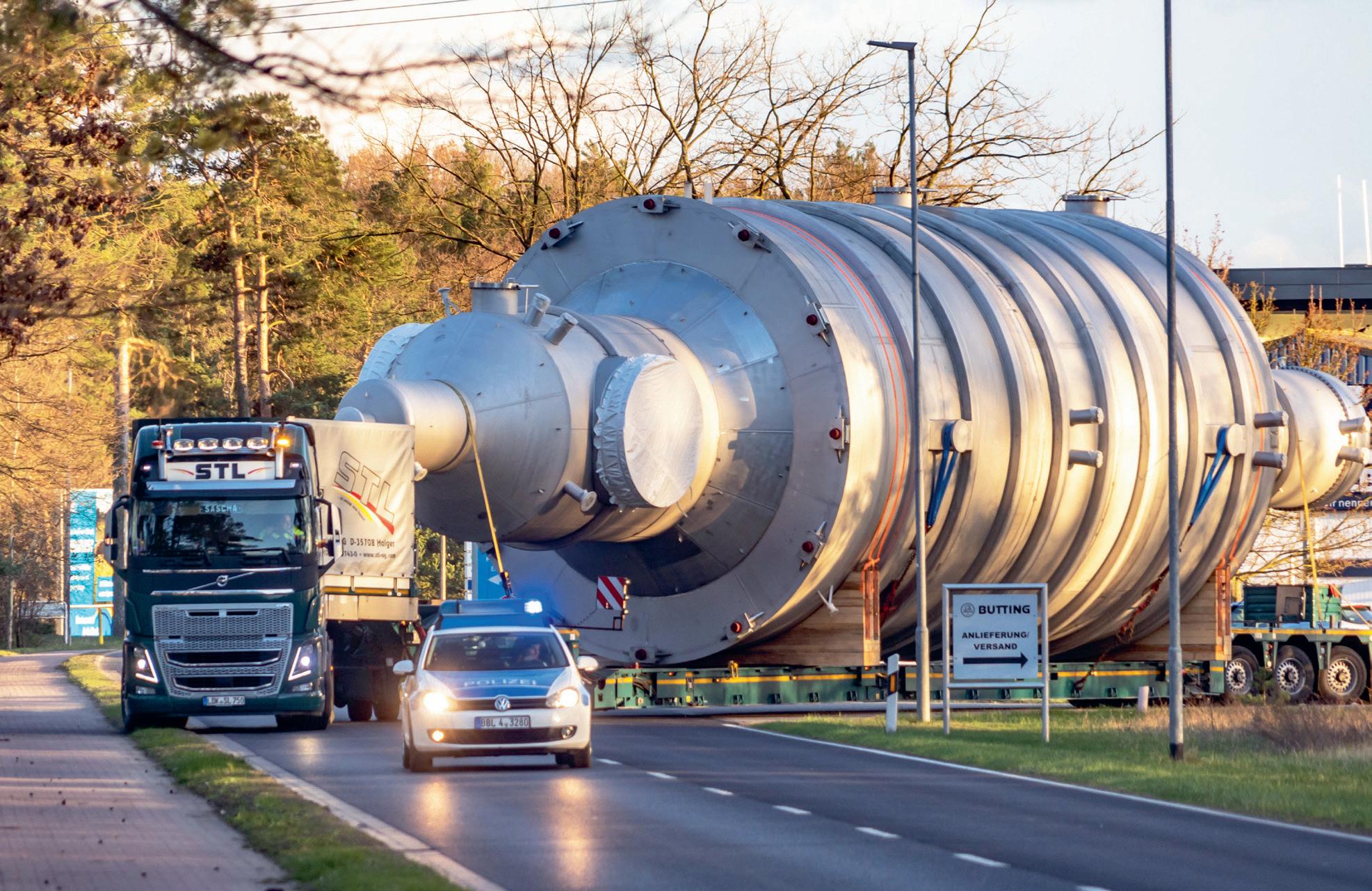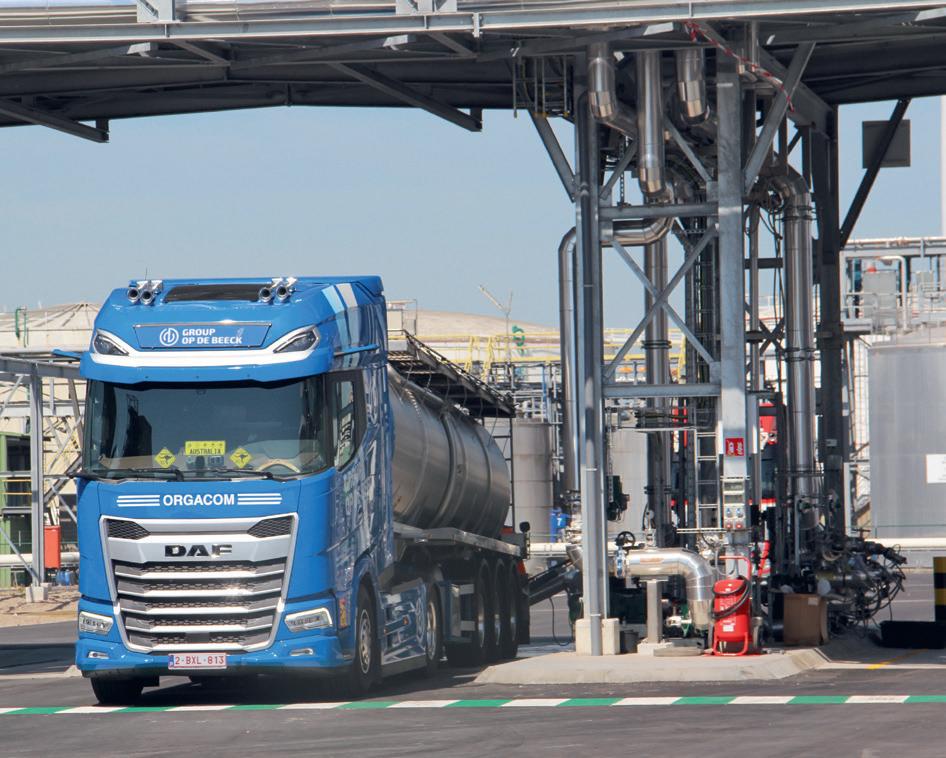
7 minute read
Cargill Turning waste oil into green fuel
Turning waste oil into green fuel
Cargill ventures into totally new feld
The new biodiesel plant (on the foreground) will produce 115,000MT per year of third-generation biodiesel.
Photo courtesy of Cargill.
In June, Cargill offcially opened a state-of-the-art advanced biodiesel plant at its site in Ghent. Converting liquid waste oils and fats into third-generation renewable fuel, the facility marks the frst foray of the American food multinational into a totally new feld. It also strengthens the position of North Sea Port as a major hub for the production of alternative fuels and as a breeding place for the circular economy. And more is to come, Cargill announced.

At the grand opening of the new plant, which is one of the largest waste-to-biofuel facilities in Europe, David McLennan, CEO of Cargill, made it perfectly clear that this was not just another project for the multinational. “We’re marking a new milestone in innovation in Ghent and one that has the potential to transform the transportation and shipping industry, to support Europe’s transition to a carbon-neutral future and to create a new model for a circular economy. This is a bestin-class example of how innovation, partnership, and focus on the environment can drive real economical results. It also demonstrates that businesses like Cargill can lead the way and support our customers’ decarbonisation journey.” Alongside other alternative fuels, the advanced biodiesel produced at the facility will mainly be used by the maritime and trucking industry, which represent almost a quarter of Europe’s greenhouse gas emissions. This will allow these sectors and
Photo courtesy of Cargill.
An impressive special convoy was needed to bring in the giant distillation column – nicknamed ‘Big Bertha’ – that is at the very heart of the new installation.

their users to lower the carbon footprint associated with their supply chain and distribution activities. Cargill is committed to this task: in 2020, it was one of the founding partners of the Maersk Mc-Kinney Moller Center for Zero Carbon Shipping.
Ground-breaking development
“We are providing a concrete, cost-effective solution that meets global renewable energy demands, respects environmental needs, and helps customers realise their greenhouse gas commitments.”, states Alexis Cazin, Managing Director for Cargill Biodiesel & Carbon EMEA. It is a ground-breaking development for Cargill, he underlines. “Until today, waste recycling was not part of our core business, but sustainable development has truly become a core value for us. This plant is part of our contribution to the fght against global warming. It is also a contribution to the energy independence of Europe. Cargill is not shy of making bold steps when there is both a purpose and a business case.” The frst discussions started in 2017. “There was some wishful thinking about building a new plant with a technicality we did not master”, Alexis Cazin recalls with a smile. The project took fve years to complete, suffering some delays due to the COVID-19 pandemic and foods on the Rhine that halted delivery of essential equipment like electric wiring.
New technology
Ghent became the frst Cargill plant employing industry-leading waste-processing technology to convert all types of liquid waste oils and fats, including cooking oils, tallow, and residues from edible oil refnery – products that previously were disposed of or relegated to low-value applications – into advanced biodiesel. “That is the magic of this plant: we take some of the worst feedstocks and we turn them into a distilled, transparent, topnotch product.” The technology designed by greentech solutions provider BDI was completely new to Cargill. It has already been implemented in two other plants in the world, in California and Hungary, but the Ghent facility is twice as big in terms of capacity and thus presented a new challenge. “The production process requires a pressure of 80 bars and a temperature of 260°C. So far, we were not used to work at such high levels of pressure and temperature. In our existing biodiesel plant, we work at atmospheric levels and at a much lower temperature”, Plant Manager Steven Matthijs explains. One of the most impressive moments in the building process was when a special convoy brought in the giant distillation column – nicknamed ‘Big Bertha’ – that is at the very heart of the new installation. But the new plant has many other special features. The operators who control the fully automated installation are sitting in an explosion-proof bunker, which also houses a laboratory where production samples can be analysed. For the production of the steam needed in the process, Cargill relies on the biggest hot oil boiler in Europe. Running on a 24/7 schedule, the biodiesel plant also creates twenty new direct jobs and 60 indirect jobs. The plant operators were hired a year ago and underwent a thorough training. Total direct employment at Cargill’s Ghent site rises to close to 170,
when including the oilseeds crushing plant and the existing, frst-generation biodiesel Bioro facility. The new plant does not interact at all with these two other facilities, if only to avoid any risk of contamination.

Local and worldwide sourcing
The investment of USD 150 million in the Ghent plant allows for the production of 115,000MT per year of third-generation biodiesel, replacing the yearly diesel consumption of 150,000 cars or 10,000 trucks, and avoiding the equivalent of 370,000t of CO2 emissions and the disposal of 120,000t of waste each year. Procurement of the needed feedstocks – some 130 to 150,000t depending on the products involved – will happen on a scale ranging from local to worldwide, with the main volumes originating in Europe. Flows will be coming in by truck, inland barge, or sea-going vessels. Trucks and barges will be handled directly at the plant, which has a mooring quay for inland vessels at the adjacent Moervaart. Dedicated pipelines will connect the plant to the waterside. Sea-going vessels will deliver their cargo at a new tank farm logistical partner Ghent Transport and Storage (GTS) is building at the nearby Kluizendok, on the left bank of the sea canal to Terneuzen, under a new joint-venture named Ghent Renewables, of which Cargill holds a 20% share. These feedstocks can receive a pretreatment there if needed before being shipped by barge to the Moervaart. Mr Cazin expects that about half of the feedstocks will originate from inside Cargill in about three years’ time, helping the group in its own decarbonisation and zero-waste drive. “We have plants in every part of the world. It takes time to organise the procurement, map all the waste we have and to redirect it to where we can process it. In Ghent we will be able to maximise a number of internal fows and to valorise part of our waste and by-products.” The biodiesel is destined to European producers of biofuels, with maritime bunkering as one of the primary markets, but also chemicals, paints, and so on. Cargill can store the new biodiesel on its own premisses in three tanks with a capacity of 11,000m³ each. Actual production started in July, but the further fnetuning of the whole process will take months. Outgoing fows will mainly be water-bound, again by barges and ships in the frst place, but the factory has four of its own loading stations for trucks.

More to come
Alexis Cazin had a fnal message for the audience attending the offcial ribbon-cutting ceremony. “This new plant also confrms our long-term commitment to the Ghent tech valley and to North Sea Port. We have found here an ecosystem of stateof-the-art infrastructure, highly specialist partners, pragmatic and supportive institutions, excellent universities and all kinds of innovations that convinced us that Ghent is the ideal location for such an investment. We will not stop with this project. More is to come on circular economy.” The Ghent site still offers the space required for these additional activities. Daan Schalck, CEO of North Sea Port, could only applaud. “An investment like this one is about reinventing ourselves to become more sustainable. With the new lock in Terneuzen, which will open next year, new opportunities will arise. Our strategy concentrates on industry, added value, and employment, and aims at circularity in the major sectors in which our port is active. Cargill’s new plant fts perfectly into the ecosystem we are building for new alternative fuels.”
Photo courtesy of Cargill.
David McLennan, CEO of Cargill: “This is a best-in-class example of how innovation, partnership and focus on the environment can drive real economical results.”
Trucks and barges will be handled directly at the plant.
Photo courtesy of Jean-Louis Vandevoorde.










